- Home
- Bertolt Brecht
Bertolt Brecht: Mutter Courage und ihre Kinder 2 Page 2
Bertolt Brecht: Mutter Courage und ihre Kinder 2 Read online
Page 2
The published text of the play, which appeared the same year, reads like a shortened and somewhat subdued version of the 1924-25 script, with The Elephant Calf separated off as an appendix with the very Pirandellesque subtitle or the Demonstrability of Any Conceivable Assertion. The direction saying that this should be performed in the foyer only came later, nor does it ever seem to have been followed in Brecht’s lifetime. This version also gives a melody and a piano accompaniment for the Man equals Man song (derived allegedly by Brecht and Hauptmann from Madame Butterfly), which subsequently disappeared from the play. Though it might have been expected that Piscator, who frequently complained about the dearth of plays for his new company, would give it its Berlin première, there is no sign that he even considered this; nor did he ever himself direct a Brecht work before 1945. On the contrary, it was Piscator’s rivals and former employers at the Volksbühne who next staged it, in January 1928, using Neher once again as the designer, directed by another kindred spirit, Erich Engel. Heinrich George was the Galy Gay, with Weigel as a shingled, raucous-voiced Begbick in riding breeches and boots. It looks as though the text this time was severely shortened, cutting out scenes 5 and 7 and rolling 4, 6 and 8 together to make one long canteen scene; the play ended with scene 9.
The aim seems to have been to make this production more sharply anti-militarist, but it clearly did not satisfy Brecht. At the beginning of 1930, however, Leopold Jessner resigned as director of the Berlin Staatstheater – partly on account of the failure of a boxing play by Brecht’s American friend Reyher, which Hauptmann had translated – and was succeeded by Legal, who must have had good memories of Man equals Man since he was quite willing to see it staged again. The surprising thing now was that in this time of economic cuts and incipient cultural conservatism he let it be directed by Brecht himself, whose long-standing ambition to direct his own plays had generally been thwarted so far. The result was that generally unpopular but highly original production of February 1931 which was seen by the visiting Soviet playwright Sergei Tretiakoff and ‘produced a tremendous impression on him’, second only (he said) to that made by Meyerhold’s 1922 production of Le Cocu magnifique.
Giant soldiers armed to the teeth and wearing jackets caked with lime, blood and excrement stalk about the stage, holding on to wires to keep from falling off the stilts inside their trouser legs.
As indeed we see from the many surviving photographs, though in fact only two of the three monsters were on stilts (the other being grotesquely padded out) while the wires appear to be those of the half-curtain in what was perhaps the lightest and subtlest of all Caspar Neher’s sets. Dwarfed by the soldiery, who already seem a long way from Kipling, are the small figures of Weigel, as a rather more mature and less masculine Begbick, and the round-eyed Peter Lorre, the relatively obscure but greatly gifted young actor who played Galy Gay. Brecht made him an ‘Irishman’, and evidently did not follow Neher’s drawings, where he has a red-brown skin.
So far as the text went two things distinguished Brecht’s interpretation at this time. First of all, he made Lorre deliver his speeches in a broken, jerky manner, so as to emphasise the fact that they were a stringing-together of contradictory passages, each with its own specific attitude or ‘gest’. (His answer to the critics who took exception to this will be found on pp. 268-71.) Secondly he yet again rewrote the play, this time with the advice of Dudow and Bernhard Reich, basing himself on the stage script of 1930 and greatly reducing its more frivolous aspects. Thus Begbick’s daughters went out, as did the Man equals Man and Drinking Truck songs with their Kipling echoes; Bloody Five too became Germanised as the much less farcical-sounding Blutiger Fünfer. For the production (though not for the version subsequently published) Begbick’s Interlude speech was shifted to make a prologue. Her ‘Song of the Flow of Things’ made its first appearance, closely recalling the ‘Reader for Those Who Live in Cities’ poems which Brecht had written in 1926-27; so too did most of the passages of spoken verse. This time Kurt Weill wrote the music, which included a ‘Nachtmusik’ and a ‘Schlacht-’ (or Battle-) ‘musik’. Unfortunately it disappeared after Hitler’s advent to power two years later, and has never since been found.
In 1938 the play was again published as part of the exiled Malik-Verlag’s edition of Brecht’s work, using a text evidently close to that of Brecht’s production. It was never staged during the Nazi era, though there is an English version of scene 1 in Brecht’s handwriting dating from his years in California which suggests that he may have thought of doing something with it there (this has been used, almost unamended, in our version since it sounds so like his authentic voice). Nor was it one of the plays which Brecht worked on with the Berliner Ensemble, so that it is difficult to tell how his final version might have turned out. What we now have in his German Collected Works (the basis for our edition) is the 1938 version as rather hurriedly amended when his German publishers began republishing the plays in the 1950s not long after his return to East Berlin. To this he once again appended The Elephant Calf, which had not been published at all in 1938. But none of this was tried out by him in the theatre, as he always wished before accepting a text as final.
* * *
The whole tangled story is of course grist to the slow mills of what some term Brechtforschung and others, less flatteringly, ‘the Brecht industry’; for students and scholars can spend happy hours trying to decide what Brecht really meant and at what point he meant it. The reader too can get considerable enjoyment from simply taking the end product as it comes, appendix and all; and if this is not enough there is some fairly amazing material in the notes. But for anybody wishing actually to perform the play the problem is not so easy. Here the interpreters have differed widely, perhaps because so few have distinguished between the different layers making up the text as we now have it; thus it is not uncommon to find passages added in 1931 being taken virtually as the starting-point of the whole affair. Roughly speaking there seem to be three main approaches. One is to treat this play as the first true example of the ‘epic theatre’ advocated in Brecht’s theoretical writings of the 1920s, and therefore as a significant piece of formal theatrical innovation. Another is to regard it as something of a confession: a denial of the importance of individual personality and specifically of Brecht’s own, culminating in the episode where the sergeant castrates himself in a bloody parody of Lenz’s The Tutor, an eighteenth-century play which Brecht was to adapt and stage much later. Finally there is the devoutly Marxist-Leninist view, according to which Galy Gay is a symbolic victim of capitalism, whom the British can turn into cannon-fodder because his job has infected him with petty-bourgeois values. He ends by being caught up in what Ernst Schumacher calls
a piece of grisly colonial reality. The atrocities committed by colonial armies in Vietnam, Korea and other oppressed lands are still awaiting portrayal; or are they too great for any writer’s imagination?
Far be it from us to tell potential directors which of the possible lines they should choose. For the play has not really got one; it is more a tangle of threads, each starting at a different point in the playwright’s own evolution and each leading in a different direction. But there are certain things which should not be ignored. To start with, this is a play which is easily taken too solemnly (which is not the same thing as seriously), though the temptation is perhaps less in this country, where the irony and humour involved in Kipling’s approach to British India are not always overlooked. Nor is there anything very new about its structure compared with the episodic form of Brecht’s own earlier plays, or the use of acrobatic and music-hall methods by Eisenstein and others around 1922-23. The nature of its concern with ‘personality’ too can be misunderstood, for on the one hand the 1920s were a time of collective undertakings, even in the arts, where the ego had necessarily to make concessions, while on the other Brecht’s specific bête noire – the notion of the Charakterkopf whose very features single him out as ‘a personality’ – probably goes back to some youth
ful irritation. Certainly it long antedated his first reading of Karl Marx, though the notion of the man who doesn’t live but ‘is lived’ does indeed stem from his private, quasi-dialectical vision of the world as continually in flux. Why should identity itself not be part of that flux too?
* * *
Although the opera Mahagonny (to give it its short title) is often placed after The Threepenny Opera in chronological arrangements of Brecht’s works, in fact it was started almost a year before Brecht began work on the latter, and his general conception of it goes back earlier still. It was Mahagonny that inaugurated the collaboration with Kurt Weill, and unlike The Threepenny Opera, where Weill was brought in at a relatively advanced stage to set the songs, it was from the first a cooperative venture. Mahagonny was durchkomponiert, or set to music right through. Not only the song texts but the whole structure was jointly established in such a way as to offer prospects of a more radical kind of work, an ‘epic opera’ whose form, content and ethos would reflect the considerable area of agreement between two highly original minds.
Like Strauss and Hofmannsthal or Gilbert and Sullivan, Brecht and Weill were in their own way peculiarly fitted for the common task. When they met for the first time in March 1927 the poet was just twenty-nine, and his experience of performing his own songs, often to home-made tunes, had accustomed him to writing for singing; moreover he had been married to an opera singer, Marianne Zoff, for whom he thought of writing a libretto. Two years younger, the composer had since 1925 been a most productive writer, contributing regular articles to the new radio journal Der deutsche Rundfunk on music and a variety of other cultural topics. In 1924 he had met Georg Kaiser, the one Expressionist playwright respected by Brecht, and had thereafter collaborated with him on two operas; while around the same time he also worked with the poet Iwan Goll who had first proclaimed the death of that school. His marriage too had been to an actress: the youthful Lotte Lenya whose voice was to give its very timbre to so many of their songs.
Right away, according to Weill, his conversation with Brecht turned to ‘opera’s possibilities’ and the notion of ‘a paradise city’ as a theme echoing (as we can now see) certain ideas which Brecht had had in his head for some time. For even before moving to Berlin in the autumn of 1924 he was using the private codename ‘Mahagonny’ for some of the crazier aspects of Bavaria (then in the aftermath of Hitler’s failed coup), and following this he had written the first three ‘Mahagonny Songs’ with their vaguely Wild West imagery of Pokerdrinksalons and the like; a ‘Mahagonny opera’ indeed was part of his mental luggage for the move. Though he did nothing to develop this further during the subsequent two and a half years, his new collaborator Elisabeth Hauptmann had studied English and she wrote him the two English-language ‘Mahagonny Songs’ which have ever since figured among his poems. With her he had started working on two related projects: an opera to be called Sodom und Gomorrah or The Man From Manhattan, and a radio play called Die Sintflut (The Flood).
The opera project which the two men instantly began to discuss aimed accordingly to deal with the biblical theme of the Cities of the Plain; but in terms of the Amerikanismus prevalent in Germany after the stabilisation of 1923/24. Under the impact of the latter The Flood had already become known as Collapse of Miami, the Paradise City, for which Hauptmann had made a collection of newspaper cuttings dealing with hurricanes, and which clearly underlay the new scheme from the start. Though nothing is known of Weill’s contribution at this initial stage it is already evident that if the outward trappings of the opera were to be modish and up-to-the-minute its message would be a Jeremiah-like warning derived from both men’s knowledge of the Old Testament. A solemn moral was to be wrapped in an enjoyably flippant package.
Almost at once there was an interruption. Weill was already an established contributor to the new music festivals at Donaueschingen and Baden-Baden, and in the spring of 1927 he was commissioned to provide one of a batch of very short operas to be performed at the latter that summer. This struck him as a perfect pretext for what he termed ‘a stylistic exercise’ for the new project, so before either partner got down to work on the opera proper the so-called Songspiel or Little Mahagonny was prepared and performed. This consisted of the five ‘Mahagonny Songs’ from Brecht’s first book of poems (including Hauptmann’s Alabama and Benares Songs) followed by the unpublished ‘Poem on a Dead Man’ as a finale; and with Brecht’s participation it was staged in a boxing ring in front of projections by his friend Caspar Neher. Lenya was one of the singers. The milieu was mock-American, the characters bearing such names as Jessie, Bessie, Charlie, Billy and so forth; and this was matched by Weill’s use of the jazz idiom, which took one or two of Brecht’s own tunes as a jumping-off point. The other works presented at the same time were by Milhaud, Hindemith and Ernst Toch, Hindemith being the festival’s principal moving spirit. His contribution Hin und Zurück, in which music and action alike run backwards from a midway point, was based on a Berlin revue sketch.
The Little Mahagonny was a success, even though there seems to have been no question of performing it elsewhere. After the show, in Lenya’s words,
suddenly I felt a slap on the back, accompanied by a booming laugh: ‘Is here no telephone?’ It was Otto Klemperer. With that, the whole room was singing the Benares Song, and I knew that the battle was won.
This came at a moment when the ‘New Objectivity’ of the painters (formally launched in the Neue Sachlichkeit exhibition of 1925) seemed to be merging in a wider movement of a down-to-earth, deliberately impersonal yet socially critical kind, of which Amerikanismus with its cult of jazz and sport formed part. Novel as their contribution was, Weill and Brecht were by no means alone in this, for Ernst Křenek’s jazz opera Jonny spielt auf had already been performed at Leipzig at the beginning of 1927, and a whole new wave of Zeitopern or ‘operas of the times’ was to follow. Soon the critic Herbert Ihering was writing of Brecht as part of a modern musical-theatrical complex stretching from Chaplin and Piscator to the experiments of Klemperer, Hindemith and Weill: ‘All that has hitherto been running along parallel or divergent paths is now joining up.… The age of isolation is over.’
After the summer holidays the three collaborators – for from now on Neher was a vital part of the team – got down to serious work on the opera libretto, which seems to have taken nearly a year. Their aim was to create an ‘epic opera’ of a new kind, in which a sequence of self-contained musical units would correspond to a ‘step by step juxtaposition of situations’ on the model (evidently) of Man equals Man. Projections like those used at Baden-Baden would add the third dimension to this scheme, which was based on Brecht’s idea of an alternative to the integrated Wagnerian Gesamtkunstwerk: the new principle which he termed ‘the separation of the elements’. What this amounted to in practice was a variety of montage, the major structural principle of the decade, and so far as Brecht’s share was concerned he used his previous writings as the main source of raw material for it. On to the nucleus of ‘Mahagonny Songs’ used in the Songspiel therefore were grafted early poems like ‘Tahiti’ and ‘Lucifer’s Evening Song’ dating from his youth in Augsburg as well as city poems dating from 1926-27 which reflect his first appalled reactions to Berlin. The hurricane advancing on Pensacola came, complete with its thousand victims and its diagrammatic arrow, from a report in the Chicago Daily News of 22 September 1926 which was among the Collapse of Miami, the Paradise City material. Leokadia (or Ladybird) Begbick is a self-evident importation from Man equals Man, Trinity Moses a quasi-Biblical guide through the wilderness to the Promised Land. Such was the mixture used to provide the required musical ‘numbers’.
This work had to be fitted in between a succession of more or less demanding distractions. First of all came Brecht’s new role as one of the team of dramaturgs for Piscator’s Communist-inspired company at the Theater am Nollendorfplatz, which staged four epoch-making productions in the 1927-28 season. Here he found a highly original approach to the use of
film, slide projections and other new technical devices, his work on the Schweik production in particular making a lifelong impression on him. Weill too wrote incidental music for one of the productions.
The particular plays which he was trying to write – notably Joe P. Fleischhacker, based on Frank Norris’s novel The Pit about the Chicago wheat market, and Decline of the Egoist Johann Fatzer about soldiers deserting in the First World War – were neither performed there nor even completed. Indeed from Man equals Man in 1926 to Saint Joan of the Stockyards in 1931 he remained unable to finish the large-scale plays that preoccupied him most.
* * *
The critical interruption came in March-April 1928, when Piscator had taken on a second theatre and was fast heading for bankruptcy. Some three months earlier a new management had been set up in Berlin, headed by a young actor called Ernst-Josef Aufricht, once a member of Berthold Viertel’s much respected company ‘Die Truppe’. Around Christmas he had been given 100,000 marks by his father with which to open his own Berlin theatre, and he used this to rent the medium-sized late nineteenth-century Theater am Schiffbauerdamm not far from Reinhardt’s Deutsches Theater. He booked Erich Engel, then busy with Brecht’s Man equals Man at the Volksbühne, to direct the opening production, if possible to coincide with his own twenty-eighth birthday on 31 August. All that remained was to find a play. This was not quite so simple, even after he had brought in a young friend of Karl Kraus’s called Heinrich Fischer to help him and act as his deputy. Kraus, Wedekind, Toller, Feuchtwanger, Kaiser, even the much older Sudermann were in turn considered or actually approached, but to no effect. Then one of those happy accidents occurred which go to make theatre history: Fischer ran into Brecht in a café, introduced him to Aufricht and asked if he had anything that would answer their needs. Brecht’s own work in progress – presumably Fleischhacker – would not do; it was already promised – presumably to Piscator – and Aufricht appears to have been bored by his account of it. But Brecht also mentioned a translation of John Gay’s The Beggar’s Opera which his collaborator Elisabeth Hauptmann had begun making the previous November. This eighteenth-century satire had been an immense success in Nigel Playfair’s revival at the Lyric, Hammersmith some five or six years earlier, and to the two entrepreneurs the idea ‘smelt of theatre’. They read all that had so far been written, under the provisional title Gesindel, or Scum, and decided that this was the play with which to open..

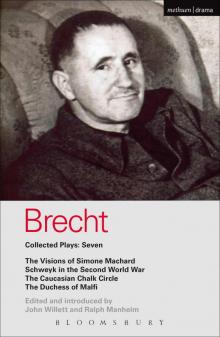 Bertolt Brecht: Mutter Courage und ihre Kinder 7
Bertolt Brecht: Mutter Courage und ihre Kinder 7 Bertolt Brecht
Bertolt Brecht Bertolt Brecht: Mutter Courage und ihre Kinder 6
Bertolt Brecht: Mutter Courage und ihre Kinder 6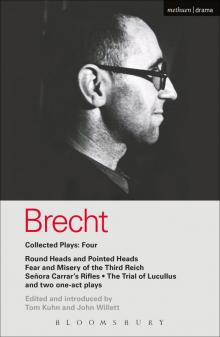 Bertolt Brecht: Mutter Courage und ihre Kinder 4
Bertolt Brecht: Mutter Courage und ihre Kinder 4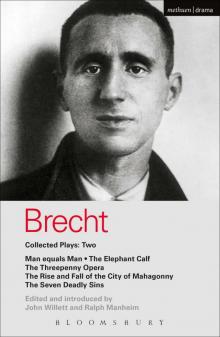 Bertolt Brecht: Mutter Courage und ihre Kinder 2
Bertolt Brecht: Mutter Courage und ihre Kinder 2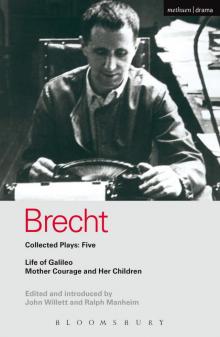 Bertolt Brecht: Mutter Courage und ihre Kinder 5
Bertolt Brecht: Mutter Courage und ihre Kinder 5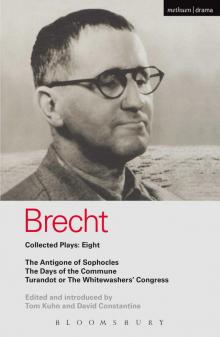 Collected Plays, Volume 4 (Bertolt Brecht: Plays, Poetry & Prose) 8
Collected Plays, Volume 4 (Bertolt Brecht: Plays, Poetry & Prose) 8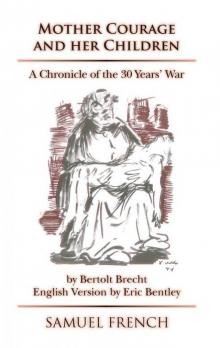 Mother Courage and Her Children
Mother Courage and Her Children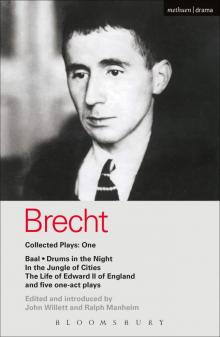 Bertolt Brecht: Mutter Courage und ihre Kinder 1
Bertolt Brecht: Mutter Courage und ihre Kinder 1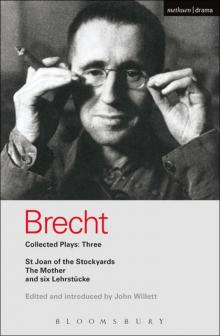 Brecht Collected Plays: 3: Lindbergh's Flight; The Baden-Baden Lesson on Consent; He Said Yes/He Said No; The Decision; The Mother; The Exception & the ... St Joan of the Stockyards (World Classics)
Brecht Collected Plays: 3: Lindbergh's Flight; The Baden-Baden Lesson on Consent; He Said Yes/He Said No; The Decision; The Mother; The Exception & the ... St Joan of the Stockyards (World Classics)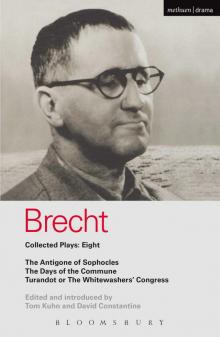 Brecht Plays 8: The Antigone of Sophocles; The Days of the Commune; Turandot or the Whitewasher's Congress: The Antigone of Sophocles , The Days of the Comm (World Classics)
Brecht Plays 8: The Antigone of Sophocles; The Days of the Commune; Turandot or the Whitewasher's Congress: The Antigone of Sophocles , The Days of the Comm (World Classics) Brecht Collected Plays: 1: Baal; Drums in the Night; In the Jungle of Cities; Life of Edward II of England; & 5 One Act Plays: Baal , Drums in the Night , In the Jungle of Ci (World Classics)
Brecht Collected Plays: 1: Baal; Drums in the Night; In the Jungle of Cities; Life of Edward II of England; & 5 One Act Plays: Baal , Drums in the Night , In the Jungle of Ci (World Classics)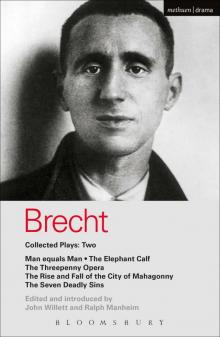 Brecht Collected Plays: 2: Man Equals Man; Elephant Calf; Threepenny Opera; Mahagonny; Seven Deadly Sins: Man Equals Man , Elephant Calf , Threepenny Ope (World Classics)
Brecht Collected Plays: 2: Man Equals Man; Elephant Calf; Threepenny Opera; Mahagonny; Seven Deadly Sins: Man Equals Man , Elephant Calf , Threepenny Ope (World Classics)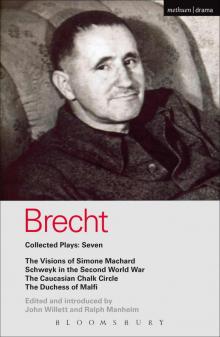 Brecht Collected Plays: 7: Visions of Simone Machard; Schweyk in the Second World War; Caucasian Chalk Circle; Duchess of Malfi (World Classics)
Brecht Collected Plays: 7: Visions of Simone Machard; Schweyk in the Second World War; Caucasian Chalk Circle; Duchess of Malfi (World Classics)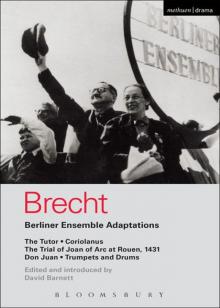 Berliner Ensemble Adaptations
Berliner Ensemble Adaptations Brecht Collected Plays: 5: Life of Galileo; Mother Courage and Her Children (World Classics)
Brecht Collected Plays: 5: Life of Galileo; Mother Courage and Her Children (World Classics)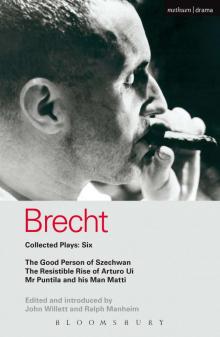 Brecht Collected Plays: 6: Good Person of Szechwan; The Resistible Rise of Arturo Ui; Mr Puntila and his Man Matti (World Classics)
Brecht Collected Plays: 6: Good Person of Szechwan; The Resistible Rise of Arturo Ui; Mr Puntila and his Man Matti (World Classics)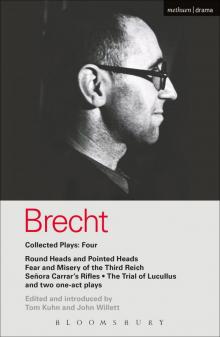 Brecht Collected Plays: 4: Round Heads & Pointed Heads; Fear & Misery of the Third Reich; Senora Carrar's Rifles; Trial of Lucullus; Dansen; How Much Is ... and Misery , Carr (World Classics)
Brecht Collected Plays: 4: Round Heads & Pointed Heads; Fear & Misery of the Third Reich; Senora Carrar's Rifles; Trial of Lucullus; Dansen; How Much Is ... and Misery , Carr (World Classics)